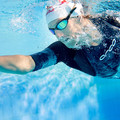
What to Wear Under a Wetsuit
HUUB Top Tips
Wondering what to wear under a wetsuit? The right kit can prevent chafing, provide warmth for your entire body, and boost your performance in the water. We spoke to the wetsuit experts at HUUB to get their insights, and so in this article we’ll explore specific options for what to wear under your wetsuit, offer tips for selecting the best fit, and guide you towards keeping warm when swimming in colder weather.
Wetsuit Undergarments - Key Takeaways
- Wearing layers under a wetsuit enhances comfort, reduces friction, and provides extra warmth for a better experience in the water.
- Consider factors like water temperature, type of activity, and personal preference when choosing undergarments to maximise comfort and performance.
- In colder temperatures consider adding a neoprene vest and other accessories constructed from neoprene material.
- No matter how well neoprene wetsuits fit, consider anti chafe cream or lube with your wet suit, it can make taking off a wetsuit easier too!
Do You Wear Anything Under a Wetsuit?
You can theoretically wear whatever you like. If you are just training, then it is common to wear swimwear (costumes, jammers, trunks and briefs). However, if you are competing in triathlon events, you will want to consider wearing a trisuit. Although you are not required to, it speeds up your transitions and prevents any decency issues during transition.
Comfort and Skin Irritation
To avoid any irritation, finding the right thing to wear beneath a wetsuit can be invaluable. Diving shorts or rash vest for the upper body creates a smooth barrier between your skin and the wetsuit, helping to prevent chafing and irritation. This is often the choice of scuba divers but can still be a tactic applied by open water swimmers.
Items such as rash guard pants are designed to fit snugly without restricting your movement, ensuring maximum comfort throughout your activity. Dive skins and rash guards are particularly effective, as they reduce friction and enhance overall comfort.
Warmth and Insulation in Cold Water
If you're swimming in cold water, you might want added layers such as neoprene vests or something like a HUUB wetsuit hood or hooded vest. An added layer will help keep the cold out. You can pair a wetsuit with thermal accessories too, such as gloves, boots, skull caps and balaclava.
For many it's personal preference, some swimmers have a high tolerance of the cold, don't be put off if people you are swimming with don't use these items. Wear what you need to keep you warm, not only for safety, but also to make your experience more enjoyable.


What to Wear for Brick Sessions
What is a brick session?
A triathlon brick session is a training workout that combines two disciplines back-to-back, typically cycling followed by running, to simulate race conditions and improve the body's ability to transition efficiently. These sessions help athletes adapt to the unique muscle fatigue and biomechanics of switching between sports during a triathlon.
For some multisport athletes, brick sessions are often incorporated into their training. Whether it is swim to bike, or bike to run, or multiple combinations of the above.
For this a trisuit is often essential to get the full effect of going from one sport directly into another. It would make sense to use an old or training trisuit for this purpose, as many top end trisuits have limited use as fabrics stretch, water repellence and other elements of their effectiveness diminish with use.
Train How You Race
Some triathletes want to train how they would race, so wearing a trisuit gets them used to the sensation of wearing one. You might not think it, but wearing a trisuit under a wetsuit will impact the fit of your wetsuit and possibly your swim stroke, especially if it's a sleeved suit.
Although some manufacturers have adapted arm positioning on trisuits to combat any restrictivness caused by sleeved suits, for instance HUUB suits feature arms neutral technology to combat this.
Added compression around chest could also cause surprise during a race, so getting used to this feeling may help settle serves or panic.
Other Wetsuit Layer Considerations
Water Temperature
Water temperature significantly influences the choice of undergarments. In colder waters, thicker wetsuits might be necessary, but they can restrict mobility. Additional layers, such as thermal vests or rash guards, provide extra warmth without compromising comfort.
Activity Type
Specific water sports might require buoyant garments like neoprene shorts for added performance.
The level of freedom of movement needed varies by activity, so select undergarments that accommodate your specific needs.


Options for Men: What to Wear Under a Wetsuit
For men, the key is to select garments designed specifically for water sports, providing the necessary support and comfort.
Swim trunks minimise bulk and provide necessary coverage. However, avoid board shorts, as they can be too bulky and uncomfortable under a wetsuit.
Rash Guards
Rash guards are another excellent option for men. They enhance comfort and provide protection against chafing, while also adding an extra layer of warmth. Typically made from lightweight polyester, a rash guard should be tight-fitting to reduce friction.
Additionally, they offer UPF 50+ UV protection, making them perfect for sun-exposed swim sessions.
Compression Shorts
Compression shorts offer additional muscle support and moisture-wicking properties. They help reduce friction and enhance comfort while wearing a wetsuit. Recommended options include diving shorts which provide both warmth and comfort. These shorts ensure a snug fit without restricting movement, making them perfect for various water sports.
Options for Women: What to Wear Under a Wetsuit
What women wear when open water swimming or triathlon training needs to offer support and comfort. The right layers will enhance your experience and ensure you can swim and maintain the correct body temperature.
Bikini or One-Piece Swimsuit
Bikinis and one-piece swimsuits are popular choices for women. Two-piece swimsuits, like bikinis, are convenient for putting on and taking off, making them ideal for extended diving trips. Avoid elements like knots, metal, beads, and thin straps, which can create discomfort under a wetsuit.
One-piece bathing suits help prevent movement and irritation during water activities, providing a secure and comfortable fit.
Sports Bras and Underwear
Sports bras and appropriate underwear provide extra support and comfort under a wetsuit. A sports bra enhances warmth and helps prevent chafing and these undergarments ensure a snug fit, allowing for freedom of movement and added comfort during water activities.
Neoprene Shorts and Rash Vests
Neoprene shorts and rash vests are excellent options. Neoprene shorts provide less bulk and discomfort as they don’t hold water well. Rash vests help maintain body heat, preventing feelings of extreme cold after diving.
Thermal rash vests offer greater mobility and comfort while helping to regulate core temperature, making them a valuable addition to your wetsuit ensemble.


Create a Thermal Barrier with Accessories for Extra Warmth
To keep your body warm, specialised accessories can make a world of difference. To maintain warmth and comfort in colder waters, accessories protect extremities and retain body heat, ensuring you stay warm even in the chilliest conditions.
Here are some to consider if you swim in open water:
Wetsuit Gloves and Booties
Wetsuit gloves and booties are crucial for keeping hands and feet warm in cold water conditions. Gloves maintain dexterity and warmth, while booties prevent foot hypothermia by providing insulation and maintaining body heat.
Thermal Hoods
Thermal hoods are excellent for retaining body heat, particularly in colder waters. They significantly reduce heat loss from the head, where a large amount of body heat escapes. Many come with adjustable chin straps to ensure a secure fit and prevent water from entering.
Wetsuit Socks
Wetsuit socks offer additional insulation for the feet, ensuring comfort and preventing blisters during water activities. Designed to provide a snug fit, these socks enhance thermal insulation, making them essential for cold-water conditions.
Tips for Easier Wetsuit Wear
Using Lubricants
Although not strictly 'worn', it is certainly worth thinking about making a wetsuit more comfortable. It is common for swimmers to use anti-chaff cream or lube. No matter how well a suit fits, it will almost certainly aggravate or rub bare skin somewhere.
There is nothing worst to have to cut a swim short due to the pain from chapped skin, particularly in salt water! Lube is also used to aid wetsuit removal, for example in the transition of a triathlon race.
Top tip. If you are racing close knit in the water with other athletes. Baby oil on the outside of the wetsuit around the lower legs, will make it challenging for those trying to grab your leg!
Layering Techniques
Effective layering techniques can make wearing a thicker wetsuit more comfortable. Streamlined undergarments help maintain a snug fit and reduce bulk.
Adding a thin layer underneath provides extra warmth without compromising mobility, ensuring a comfortable and enjoyable water experience.


Summary
Choosing the right undergarments to wear underneath a wetsuit is essential for comfort, warmth, and overall enjoyment of your water activities.
Whether you’re opting for swim trunks, rash guards, sports bras, or specialised accessories, the key is to select items that meet your specific needs.
Remember to consider factors like water temperature, activity type, and personal preference.




